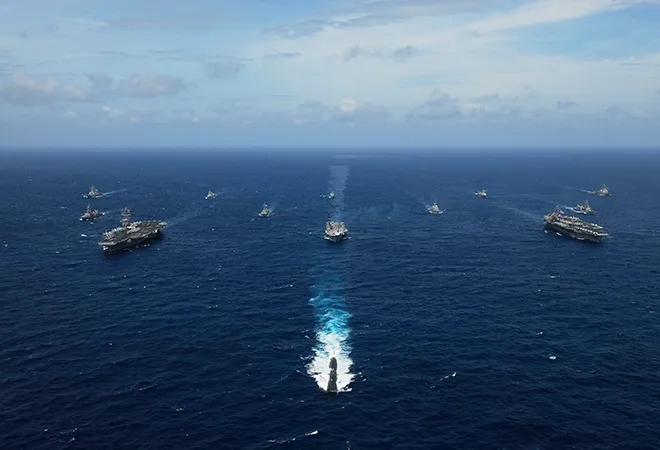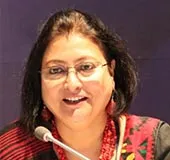
The term ‘Indo-Pacific’ is gaining currency as a new construct in recent times, with various countries using it in official statements. Despite having been in use in Indian policy circles for years, the nomenclature gained a clear meaning and vision from Prime Minister Narendra Modi’s keynote speech at the Shangri-La Dialogue in June 2018<1>. Further, he highlighted that India has been an active participant in mechanisms like the Indian Ocean Rim Association (IORA), the East Asia Summit, Association of Southeast Asian Nations (ASEAN) Defence Ministers Meeting Plus, ASEAN Regional Forum, the Bay of Bengal Initiative for Multi-Sectoral Technical and Economic Cooperation, and Mekong Ganga Economic Corridor. India also convenes the Indian Ocean Naval Symposium. Through the Forum for India-Pacific Islands Cooperation (FIPIC), India is moving towards engaging with Pacific Island countries. India’s multi-layered engagement with China as well as its strategic partnership with Russia is key to ensuring a stable, open, secure, inclusive, and prosperous Indo-Pacific.
The Indo-Pacific provides a geographic and strategic expanse, with the two oceans being linked together by the ten ASEAN countries. Inclusiveness, openness, and ASEAN unity, therefore, lie at the heart of the notion of Indo- Pacific. India does not see the Indo-Pacific Region as a strategy or as a club of limited members. Security in the region must be maintained through dialogue, a common rules-based order, freedom of navigation, unimpeded commerce, and settlement of disputes in accordance with international law. India supports a rules-based, balanced, and stable trade environment in the Indo- Pacific region. Sustainable connectivity initiatives promoting mutual benefit should be continually fostered. In this regard, India has been an important stakeholder in the New Development Bank and the Asian Infrastructure Investment Bank.
An emerging realisation in strategic circles has gained ground: that there are linkages between the Indian and the Pacific Oceans. For India, the geography of the Indo-Pacific stretches from the eastern coast of Africa to Oceania (from the shores of Africa to those of the Americas), which also includes the Pacific Island countries. For the purpose of this article, however, the focus is on the ASEAN countries and Oceania (Australia, the Pacific Island countries).
In recent times, beyond the Indian Ocean, the Western Pacific has been identified as being within the ambit of India’s security interests. The focus on maritime issues is evident from the increase in maritime exchanges led by the Indian Navy with countries such as Vietnam, Singapore, Indonesia, and Japan. India’s trade in this region is growing rapidly, with several overseas investments being directed towards the East. India has Comprehensive Economic Partnership Agreements with Japan, South Korea, and Singapore; and Free Trade Agreements with ASEAN and Thailand. The nation is also entering into negotiations for the early conclusion of the Regional Comprehensive Economic Partnership. India’s approach to the region is exemplified by its evolving ‘Act East’ Policy, comprising economic engagement with Southeast Asia and strategic cooperation beyond Southeast Asia to East Asia (Japan, Republic of Korea), Australia, New Zealand, as well as the Pacific Island countries. Nonetheless, the term lacks holistic acceptance in the region. While China is apprehensive about its connotation, there is a lurking fear among ASEAN nations that they could be marginalised if the Indo-Pacific concept takes on a more concrete relevance.
India’s efforts to advance its Indo-Pacific vision can be traced in the following spheres:
Maritime Domain Awareness: The induction of the P8-I long-range maritime patrol aircraft in 2015 at INS Rajali, Arakkonam,<2> and the inauguration of the Information Fusion Centre at Gurugram<3> in December 2018 clearly reflect India’s aims to collaborate with partner countries and multinational agencies to develop maritime awareness, share information on commercial cargo vessels, and strengthen inter-navy linkages through training and professional interactions.
Operational outreach of the Indian Navy: In July 2018, the Indian Navy put forward “new mission based deployment”<4> in the Indian Ocean, involving mission-ready ships and aircraft along critical sea-lanes of communication. The access given to the port of Sabang by Indonesia last year is already improving the outreach of the Navy.<5> The commissioning of a new air base—INS Kohassa in the Andaman and Nicobar Islands—by the Indian Navy in January 2019 to expand operational presence in the Indian Ocean is also significant.<6>
Strategic coherence: In March 2015, Prime Minister Modi put forward the concept of ‘SAGAR’ (Security and Growth for All in the Region)<7>, a maritime initiative aimed at enhancing a range of capacities, engaging with other countries, and fostering greater cooperation in the littoral. Worth mentioning in this context are the dialogues that have been conducted between India and other countries—like the 2+2 dialogues<8> with the US, Japan, and Australia, the trilateral dialogues between India-Japan and US, India-Japan-Australia (JAI),<9> Russia-India-China, India-Australia-Indonesia, and the Quadrilateral meetings between India, Japan, Australia and the US. The signing of the Shared Vision Statement of India-Indonesia Maritime Cooperation in the Indo-Pacific during Modi’s first visit to Indonesia in May 2018 is notable.<10> Modi also visited Myanmar and Malaysia in 2018. The invitation to the 2018 Indian Republic Day celebrations—extended to the leaders of all ten ASEAN countries—underscored the significance of India’s Act East policy. In April 2019, India set up an Indo-Pacific wing in the Ministry of External Affairs.<11> The division will integrate the IORA, ASEAN region, and the Quad to the Indo- Pacific table.
Joint exercises for better interoperability: The Indian Navy has been part of coordinated patrols with Indonesia (Ind-Indo CORPAT), and joint naval (AUSINDEX) and air (Pitch Black) exercises with Australia. The first ever India-Myanmar bilateral joint military exercise (IMBAX) took place in November 2017, and in 2018 the first bilateral naval exercise (IMNEX) was held. The first bilateral naval exercise between India and Indonesia—named Samudra Shakti—was conducted in 2018.
Capacity Building: In August 2018, India was given the status of STA-1 (Strategic Trade Authorisation) from the US for hi-tech product sales, particularly in the civil space and defence sectors. Furthermore, India will start defence component manufacturing for the F-16 and C-130 aircraft. India has also provided training to Vietnamese combat pilots and given technical support to the Myanmar Navy.
Maritime infrastructure: India is developing Sittwe port in Myanmar’s Rakhine State and implementing the US$484 million Kaladan transport project to connect Rakhine State with India’s northeast state of Mizoram.<12>
Trade: Trade and economic relations between ASEAN and India have seen a rise, and the two-way trade between India and ASEAN has risen from US$35 billion in 2007 to US$65 billion in 2016. Both exports and imports almost doubled over the same period, from US$14 billion and US$21 billion respectively in
2007, to US$26 billion and US$38 billion respectively in 2016 (See Figure 13). India stands as ASEAN’s 11th largest trading partner in the year 2016.
Figure 13: India’s Trade with ASEAN (USD billion)
 Source: ITC, Geneva and Exim Bank Analysis
Source: ITC, Geneva and Exim Bank Analysis
Besides the ASEAN, an upward trajectory in economic and trade relations can be seen with countries like Australia. Two-way goods and services trade between Australia and India totalled US$19.4 billion in 2015-16. Australian investment in India reached US$10.6 billion at the end of 2015, and Indian investment in Australia was at US$11.6 billion. This shows significant growth over investment levels a decade ago. With regard to increasing trade with Pacific Island countries Prime Minister Modi, while speaking at the first FIPIC Summit in November 2014, announced the setting up of a ‘Trade Office’ in India.
All these engagements portray India’s increasing involvement in the Indo-Pacific. Emphasising “inclusiveness” in the Indo-Pacific framework, countries like China and Russia are also being welcomed by India. Maintaining the delicate balance between the interests of all stakeholders will be a key challenge. Moreover, it will be a difficult task for India to make it clear to the US that there is a need to bifurcate the Quad and the Indo-Pacific construct. Thus, India needs to carefully design its Indo-Pacific policy while keeping its long-term strategic and economic interests in mind.
This article originally appeared in special report Looking Back looking Ahead.
<1> “
Prime Minister’s Keynote Address at Shangri La Dialogue”, Ministry of External Affairs, Government of India, 1 June 2018.
<2> “
Navy’s Long-Range Maritime Patrol Aircraft Boeing P-8I Dedicated to the Nation,” Indian Navy, 2015.
<3> “
Raksha Mantri Inaugurates Information Fusion Centre – Indian Ocean Region (IFC-IOR)”, Press Information Bureau, Government of India, 22 December 2018
.
<4> Sujan Datta, “
Indian Navy Informs Government about the Fleet’s".
<5> Pramit Pal Chaudhari, “
Indonesia Gives India Access to Strategic Port of Sabang”, 17 May 2018,
Hindustan Times.
<6> “
INS Kohassa – A New Bird’s Nest in the Andamans”, Indian Navy, 2019.
<7> FE Online, “
PM Modi’s Maldives Visit: Maritime Security in Indian Ocean and Development Initiatives to be Focus”,
The Financial Express, 7 June 2019.
<8> “
5Th India-Japan 2+2 Dialogue”, Ministry of External Affairs, Government of India, 19 June 2018.
<9> ANI, “JAI: Narendra Modi Term for Japan-America-India Partnership”,
Times of India, 1 December 2018.
<10> “
Shared Vision of India-Indonesia Maritime Cooperation in the Indo- Pacific”, Ministry of External Affairs, Government of India, 30 May 2018.
<11> Indrani Bagchi, “
In a Show of Intent, External Affairs Ministry Sets up Indo- Pacific Wing”,
Times of India, 15 April 2019.
<12> “
QUESTION NO.1794 KALADAN PROJECT”, Ministry of External Affairs, Government of India, 26 June 2017.
The views expressed above belong to the author(s). ORF research and analyses now available on Telegram! Click here to access our curated content — blogs, longforms and interviews.




 Source: ITC, Geneva and Exim Bank Analysis
Source: ITC, Geneva and Exim Bank Analysis PREV
PREV



